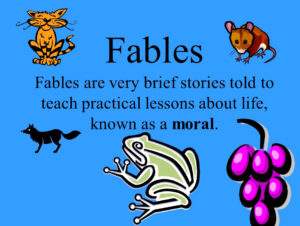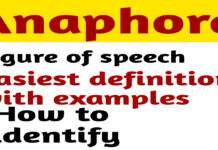Fable | Fable Meaning, Definition, Illustration
Fable | Fable Meaning, Definition, Illustration
Fable | Fable Meaning, Definition, Illustration
The word ‘Fable’ has come from the Latin ‘Fabula’ meaning a ‘discourse’ or ‘story’. A Fable is a short narrative in prose or verses the main characters of which are not human beings, but beasts, birds, or inanimate objects that point to a moral lesson. The characters are types rather than individuals which represent men and women living in society, with their frailties, foibles, sins, or vices. For example- ‘Aesop’s Fables’ in Greek, Chaucer’s ‘Nonnes Prestes Tale’ in English, ‘Roman de Renard’ in French, Vishnu Sharma’s ‘Hitopadesh’ in Sanskrit and so on.
Fable either in written or oral form is present among people in almost all languages all over the world. The Fables may be divided into two types as- (a) Traditional or Primitive Fables and (b) Literary Fables.
Traditional Fables or Primitive Fables refer to those fables that were composed orally by mostly unknown authors and have been coming down orally from generation to generation, from person to person. These types of fables were the products of the Classical as well as the Medieval Ages of literature. This type of fable belongs to the large group of folk literature. Only a few of these types of fables were compiled and to some extent reshaped by some compilers during the middle ages. Still today there are lots of fables to be collected and preserved. Otherwise, the din and bustle of the present day would bury them forever. Among these types of fables that have got preserved, mention may be made of Aesop’s Fables, Vishnu Sharma’s Hitopadesh, Chaucer’s Nonnes Prestes Tales etc.
On the other hand, Literary Fables refer to those types of Fables which are written imitating Traditional or Primitive Fables. Among this type of fables, examples may be made of George Orwell’s Animal Farm, James Thurber’s Fables of Our Time, Vikram Seth’s The Frog and Nightingale and so on.
A study of those two types of fables shows that there are some salient features that are generally common to any fables; these are- (i) characters are non-human beings as- birds, beasts, supernatural agents or inanimate objects; (ii) the characters are mostly type representing frailties, foibles, vices, sins and virtues of men and women living in society; (iii) allegorical or metaphorical in device; (iv) humorous or satirical in tone and (v) ending in moral lesson expressed by the characters or by the narrator. 0 0 0.
Fable Meaning
Read More: Simile Meaning, Definition, Illustration
Fable Meaning
N. B. The article ‘Fable Meaning, Definition, Illustration’ originally belongs to the book ‘The Rhetoric‘ by Menonim Menonimus.
Fable Meaning
Related Search:
- Fable-English Meaning
- Fable Definition and Meaning
- Allegory | Definition, Example
- Allegory Definition and Examples
- Rhetoric
- Aristotle’s Rhetoric
- Simile Definition and Meaning
- Metaphor Definition
- Using Metaphor
Books of Composition by M. Menonimus:
- Advertisement Writing
- Amplification Writing
- Note Making
- Paragraph Writing
- Notice Writing
- Passage Comprehension
- The Art of Poster Writing
- The Art of Letter Writing
- Report Writing
- Story Writing
- Substance Writing
- School Essays Part-I
- School Essays Part-II
- School English Grammar Part-I
- School English Grammar Part-II..











